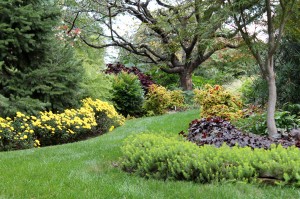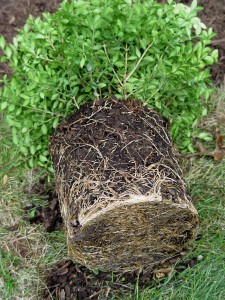Don’t Pack Away the Shovels Yet
September 16th, 2014
We’re heading down the gardening home stretch now, that time of year when we’re tempted to dig in a few mums and call it a season.
Not so fast. We should have another 6 to 8 weeks of decent gardening conditions – weeks that happen to be some of the year’s best for planting.
“Fall is for planting” isn’t just garden-center hype to get rid of plants the stores don’t want to overwinter. Fall really is a good time to plant most things. Here’s why:
* The soil temperatures are warm enough to support good root growth at least through the end of October.
* The shorter days, less intense sunlight and cooler temperatures of early fall mean less stress (i.e. “transplant shock”) for plants being evicted from their cozy pots into the untamed ground.
* Newly planted plants lose less moisture through their leaves in fall than summer, which lowers water demands.
* We usually get more rain in fall than summer, which further reduces the hose duty that new plantings require.
* Fall-planted plants will have two growing seasons under their belts instead of one (now and next spring) before having to face the grueling challenge of a summer in central-Pennsylvania clay.
* The bugs are mostly gone.
* A lot of plants go on sale from here on out.
* And, last but not least, it’s a heckuva lot more pleasant to be out there digging in late September than in an August furnace.
When plant-shopping this time of year, you’ll run into both fresh fall stock from the growers as well as spring leftovers that may not have had immaculate care over the summer.
Check the leaves and branches for bug damage, leaf spotting, leaf streaking and other signs of trouble. I’d pass on those.
If the leaves are just tired and browning, or if the spent flower stems just haven’t been snipped, or if the plant is a bit gangly or ratty from spending the summer in a small pot, don’t worry about that… especially if the price tag says 40 or 50 percent off.
What really counts is the condition of the roots. Gently slip the plants out of their pots and look for roots that are fleshy and white or creamy, not black and mushy or brown and shriveled.
The latter means the plants were either over- or under-watered.
This time of year you might also run into roots that have grown to fill the pots and begun circling around the inside. A little of that is fine. Just fray out the circling roots before planting or even make two or three vertical cuts through the roots to break up a too-tight mass.
If the roots are so badly circled that you can’t even get the plant out of the pot, that’s more of a problem. It doesn’t mean the plant won’t transplant and live happily ever after… but it lowers the odds.
If the garden center is guaranteeing the plant, you have nothing to lose. But be aware that year-end closeouts are usually not guaranteed, and neither are some of the more borderline-hardy plants that would rather not face a cold winter first thing after being planted.
Among those that would rather wait until spring: crape myrtle, cherry laurel, nandina, Southern magnolias, camellias, variegated hollies, most roses (shrub types are OK in fall), abelia, mahonia, falseholly (Osmanthus), blue Atlas cedar, vitex and crocosmia.
Here are ideas on plantings you can tackle now and in the coming weeks:
1.) Things you can plant now to enjoy right away
* Fall-blooming perennial flowers such as mums, asters, sedum, Japanese anemone and leadwort.
* Perennial flowers with colorful foliage that’ll look good until frost and then bloom next year, such as variegated liriope, variegated Jacob’s ladder, variegated brunnera, coralbells, foamflowers, foamybells, leadwort, hardy geraniums, hosta, Japanese painted ferns, ajuga, lamium and yucca.
* Hardy herbs with colorful foliage, such as purple or pineapple sage, golden oregano and golden or silver thyme.
* Cold-hardy annuals, such as pansies, violas and if the winter isn’t too bad, dusty miller, annual phlox and annual dianthus.
* Cold-tolerant fall foliage plants that you toss at winter’s end, such as ornamental cabbage and kale.
2.) Things you can plant now that will peak in fall
* Trees with great fall foliage, such as maple, stewartia, sweetgum, blackgum, dogwood, Persian parrotia and sourwood.
* Shrubs with great fall foliage, such as fothergilla, burning bush, dark-leaf ninebark, Virginia sweetspire, witch hazel and viburnum.
* Trees and shrubs with colorful fall berries, such as crabapple, dogwood, hawthorn, junipers, hollies (both evergreen and winterberry types), beautyberry, chokeberry and viburnum.
3.) Things you can plant now to enjoy next spring
* Spring-blooming bulbs, such as snowdrops, crocuses, Siberian squill, chionodoxa, daffodils, hyacinths, tulips, grape hyacinths and alliums.
* Winter-hardy, early-blooming perennial flowers, such as Lenten rose, brunnera, creeping phlox and pulmonaria.









